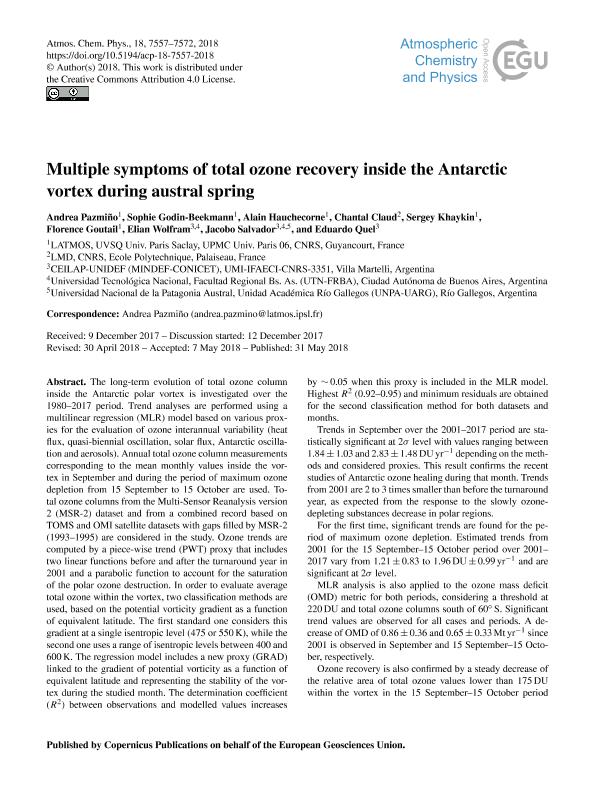Artículo
Multiple symptoms of total ozone recovery inside the Antarctic vortex during austral spring
Pazmino, Andrea; Godin Beekmann, Sophie; Hauchecorne, Alain; Claud, Chantal; Khaykin, Sergey; Goutail, Florence; Wolfram, Elian Augusto ; Salvador, Jacobo Omar
; Salvador, Jacobo Omar ; Quel, Eduardo Jaime
; Quel, Eduardo Jaime
 ; Salvador, Jacobo Omar
; Salvador, Jacobo Omar ; Quel, Eduardo Jaime
; Quel, Eduardo Jaime
Fecha de publicación:
12/2017
Editorial:
Copernicus
Revista:
Atmospheric Chemistry and Physics Discussions
ISSN:
1680-7375
Idioma:
Inglés
Tipo de recurso:
Artículo publicado
Clasificación temática:
Resumen
The long-term evolution of total ozone column inside the Antarctic polar vortex is investigated over the 1980-2016 period. Trend analyses are performed using a multilinear regression (MLR) model based on various proxies (heat flux, QBO, solar flux, AAO and aerosols). Annual total ozone column corresponding to the mean monthly values inside the vortex in September and during the period of maximum ozone depletion from September 15th to October 15th are used. Total ozone columns from combined TOMS-N7, SBUV-N9, TOMS-EP and OMI-TOMS satellite datasets and the Multi-Sensor Reanalysis (MRS-2) dataset are considered in the study. Ozone trends are computed by a piecewise trend model (PWT) before and after the turnaround in 2001. In order to evaluate total ozone within the vortex, two classification methods are used, based on the potential vorticity gradient as a function of equivalent latitude. The first standard one, considers this gradient at a single isentropic level (475K or 550K), while the second one uses a range of isentropic levels between 400K and 600K. The regression model includes a new proxy that represents the stability of the vortex during the studied month period. The determination coefficient (R2) between observations and modeled values increases by ~0.05 when this proxy is included in the MLR model. The higher R2 (0.93-0.95) and the minimum residuals are found for the second classification method in the case of both datasets and months periods. Trends in September are statistically significant at 2 sigma level with values ranging between 1.85 and 2.67 DU yr-1 depending on the methods and data sets. This result confirms the recent studies of Antarctic ozone healing during that month. Trends after 2001 are 2 to 3 times lower than before the turnaround year as expected from the response to the slowly ODS decrease in Polar regions.Estimated trends in the 15Sept-15Oct period are smaller than in September. They vary from 1.15 to 1.78 DU yr-1 and are hardly significant at 2 level. Ozone recovery is also confirmed by a steady decrease of the relative area of total ozone values lower than 150 DU within the vortex in the 15Sept-15Oct period since 2010. Comparison of the evolution of the ozone hole area in September and October show a decrease in September, confirming the later formation of the ozone hole during that month.
Palabras clave:
Ozone
,
Antartic
,
Recovery
Archivos asociados
Licencia
Identificadores
Colecciones
Articulos(UNIDEF)
Articulos de UNIDAD DE INVESTIGACION Y DESARROLLO ESTRATEGICOS PARA LA DEFENSA
Articulos de UNIDAD DE INVESTIGACION Y DESARROLLO ESTRATEGICOS PARA LA DEFENSA
Citación
Pazmino, Andrea; Godin Beekmann, Sophie; Hauchecorne, Alain; Claud, Chantal; Khaykin, Sergey; et al.; Multiple symptoms of total ozone recovery inside the Antarctic vortex during austral spring; Copernicus; Atmospheric Chemistry and Physics Discussions; 12-2017; 1-28
Compartir
Altmétricas



